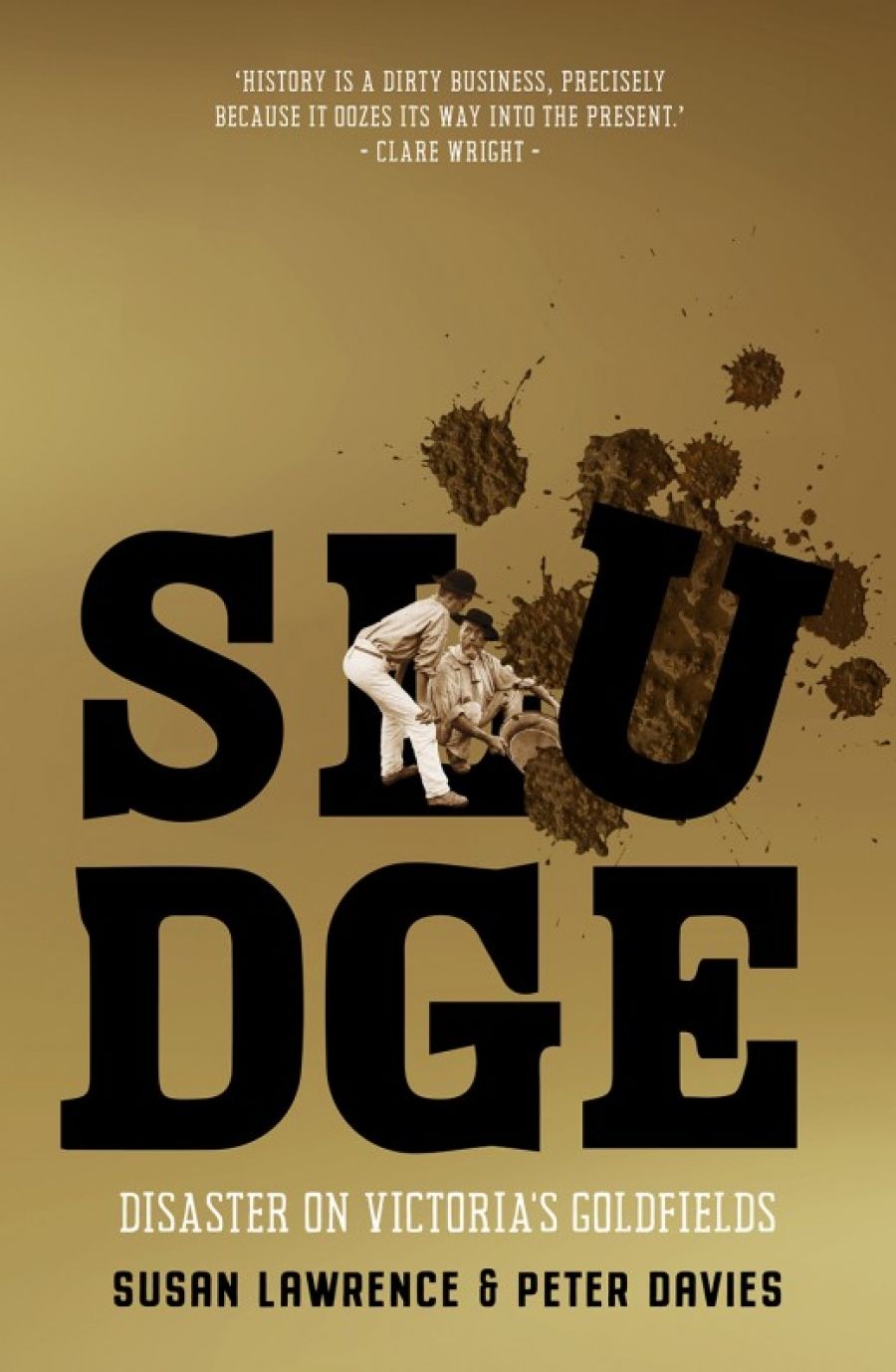
- Free Article: No
- Contents Category: Environmental Studies
- Review Article: Yes
- Grid Image (300px * 250px):

- Alt Tag (Grid Image): Sludge
- Book 1 Title: Sludge
- Book 1 Subtitle: Disaster on Victoria’s goldfields
- Book 1 Biblio: La Trobe University Press, $34.99 pb, 320 pp, 9781760641108
The facts need little embellishment: for more than half a century, gold mining generated unholy dislodgements of soil and affected three quarters of Victoria’s waterways. Consider that during the mid-1850s, up to sixty-seven million litres of sludge poured into Bendigo Creek each day. In the 1880s, on our dry continent, even a small mining claim using sluicing technology could daily consume close to a million litres of water.
Lawrence and Davies, industrial archaeologists, lead us through this environment and the industry that altered it, explaining, for example, the enduring dance of a healthy river as it accelerates around bends and then deposits sediment in slowing stretches. We join them on excursions during which they uncover a ‘remarkably intact’ water flume or the stone foundations of a water wheel. Their photograph of an interrupted cliff face offers a cross-section view of a choking blanket of hard orange soil, a silent reminder of the malevolent invasions of sludge that terrorised regional residents.
 Gold field miners (photograph from Sludge by Susan Lawrence and Peter Davies)
Gold field miners (photograph from Sludge by Susan Lawrence and Peter Davies)
Sludge poured through main streets, mired cattle, clogged waterways, strangled grape vines, engulfed fully grown trees, and drowned more than a few stray humans. It flowed from a range of mining technologies – from cradling and puddling to deep-lead mining, quartz crushing, hydraulic sluicing, and bucket dredging.
Water was essential to washing gold from its gritty or rocky casing, both for individual diggers and corporate players. From the 1850s, a ‘spaghetti’ of races in gold centres such as Beechworth diverted water along narrow channels, sometimes into entirely different catchment systems. The colonial administration tussled with British precedent about water access at a time of broad discussion regarding land ownership, eventually developing a local model that retained government ownership of water while granting licences for individual use.
From a morass of innovation, legislation, and litigation emerged the enterprising ‘water boss’, with his (for they were almost all male) army of underlings, including ‘race keepers’. The authors deftly navigate technical content to build a granular picture of how technology shaped the hierarchy of a goldfield, a milieu in which local authorities decided how the ‘creek rights’ of miners could co-exist with the ‘bank rights’ of the richer water bosses. This water wrangling surged to highs of destructive ingenuity during the 1870s with the arrival of ‘giant nozzles’ from California, whose mouths yawned to an immense nine inches in diameter.
Resident groups, supported by parliamentary champions, mobilised in outrage at the power of these sluicing nozzles to blast away riverbanks more than thirty-six metres high, just one in a litany of protests against the menace of mining that finally, after decades of be-sludging, began to prompt stricter regulation.
For the reader versed in the politics of modern-day environmental stalemates, the historical sludge debates seethe with recognisable iterations of denial: questionable attempts at self-regulation; an industry that eulogised itself with every mention of environmental responsibility; a plea about the ‘small man … the fellow who is making a living with the cradle and tub’; and even a tendentious claim that tailings improved Bendigo’s soil. As Lawrence and Davies show, only changing economic conditions, including agriculture’s growing contribution to the colonial economy, allowed the balance to tip away from mining interests. Pragmatism triumphed.
Sludge ultimately speaks to our own time. Environmental protection laws grow from the activism seeded during past catastrophes. Just as miners brawled over water races in the 1850s, the equity of water allocations along the tendrils of the Murray–Darling Basin fuels interstate animosity. Victorians live with legacy contaminants in the soil thanks to gold mining. In our rivers, ‘sand slugs’ of mid-sized sediment from mining to this day dislodge during heavy flows and lurch downstream, stifling aquatic habitats.
We unstick ourselves from Sludge in a meditation on lasting entanglements between human and environment, both locally and in a state of global interconnection. Lawrence and Davies remind us that each time we purchase a smart phone we bolster a global network of consumption and extraction. It is a wicked problem, and one that generates vital conversations about resources, climate justice, conservation, and the agency of ecosystems that can still somehow flourish again, despite our worst transgressions.


Comments powered by CComment